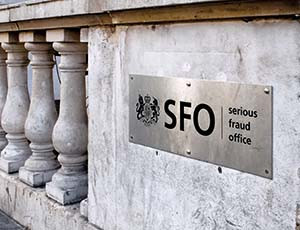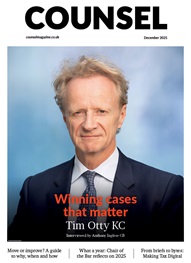*/

On 10 December 2021, the Serious Fraud Office (SFO) was rebuked by the Court of Appeal in respect of its conduct in the case of Akle [2021] EWCA Crim 1879 – the latest development in the long-running bribery investigation into Unaoil and its leading family, the Ahsanis. Central to the court’s criticism was the SFO’s dealings with private investigator and Ahsani family ‘fixer’, David Tinsley.
The case is the most recent example of the increasing lengths to which those under investigation will go to protect their interests. In November 2021, it was announced that Dechert’s former head of white-collar crime had settled a High Court claim against Kazakh mining company ENRC over the corporate’s alleged ‘unlawful covert surveillance’.
The court’s distaste for the approach taken in Akle was evident, but it is arguable that the SFO’s errors are attributable in part to misjudgments over how to bridge the growing inequality of arms between the organisation and the savvy corporates it investigates. It would be unfortunate if this case had a ‘chilling’ effect on the SFO’s ambitions to adopt a more proactive approach in-house. A re-think of the company it keeps, active and transparent cooperation with experienced sister law-enforcement agencies, and robust use of tools already available to it could provide the rewards sought without exposure to the inevitable legal pitfalls encountered in Akle.
The SFO continues to have success in Deferred Prosecution Agreements (DPA) – in July 2021 Mrs Justice May approved DPAs against two unnamed UK companies for their part in bribery offences, bringing the total number of DPAs obtained to 12. Convictions, however, remain elusive. The agency has failed to secure a single conviction against an individual connected with a DPA. The problem is not limited to DPA cases. In February 2020, a jury took just six hours to acquit three former Barclays executives charged with fraud following a five-year investigation and a laborious presentation of a five-month trial costing millions of pounds.
The difficulties are obvious. As every seasoned prosecutor opening a criminal case to a jury knows, the key question is not just ‘can you prove it?’ but also ‘why should we care?’ Recent good publicity for the SFO in the repatriation of funds seized from corrupt Chadian officials through Foreign Aid may help, but too often the context may seem remote and the ‘victims’ difficult to discern. The clearer the case, the more proximate in time and the more visual its presentation the better.
The nature of the evidence presented also matters. While city frauds and international corruption will seldom provide the photo opportunities of bundles of cash or criminal assignations in lay-bys and greasy spoon cafes available to those who prosecute organised crime gangs and drugs importers, there are other ways in which the approach could be more jury-friendly.
The first is the use of real-time investigation: responding as it does to complaints and tip-offs, the SFO often comes late to the party and the time taken to build a ‘traditional’ case means trials are later still. It took eight years for former Serco executive Simon Marshall’s corruption trial to reach a courtroom. Resulting disclosure problems ultimately contributed to the collapse of the case.
The second is the nature of the allegations and the volume of documentary evidence presented: esoteric charges and a lack of ‘human interest’ in the evidence adduced can make it near impossible to present an engaging case to a jury. Challenges are exacerbated in the digital age: the recent data explosion not only means more material for the SFO to interrogate, adding to delay and to the disclosure burden, but also a jury bundle which can be unattractively schedule-heavy and numbers-rich.
Against that, a real person in the dock saying ‘I didn’t know’ or ‘it wasn’t me’ provides a readily acceptable narrative for jury doubt and a tempting salve for confusion or disengagement.
One approach would be to settle for pursuing corporate defendants and prioritising the DPA regime. There would be advantages, but surely it is securing convictions against guilty individuals which will really deter future criminality?
An alternative is available. Might a shift towards directed surveillance and proactive investigation result in evidence that could be put before a jury in a more digestible and persuasive format?
SFO Director Lisa Osofsky – a former US Department of Justice and FBI lawyer – has herself made no secret of her desire to implement lessons learned from her US roles and to see both covert surveillance and cooperating witnesses play a greater role in SFO investigations. In 2019, Osofsky advocated in favour of a US style informant system, inviting offenders to ‘spend 20 years in jail for what you did or wear a wire and work with us’.
Her comments were met with pushback from those who noted the obstacles and fault-lines between the UK and US criminal justice systems.
While the UK surveillance and intelligence gathering regulatory framework is more stringent than that of the US, there remains legal room within which the SFO can manoeuvre. Though not permitted to engage in the more intrusive methods of communication interception and equipment interference, the SFO is a relevant authority under Sch 1, Regulation of Investigatory Powers Act 2000 for the purposes of the use of directed surveillance and covert human intelligence sources (CHIS). Following the passage through Parliament of the Covert Human Intelligence Sources (Criminal Conduct) Act 2021, the SFO can further authorise criminal conduct by a CHIS.
Unlike the US, the UK does not have a plea bargaining system whereby prosecutors can offer incentives in exchange for cooperation. From a defendant’s perspective the current practice of informal credit from a sentencing judge is uncertain, unquantifiable and unaccountable. It is unlikely that a dynamic programme of ‘turning’ witnesses could be built without a bolder approach.
The UK system does, however, make provision for a regulated immunity regime under the Serious Organised Crime and Police Act 2005 (SOCPA). Section 71 of SOCPA provides for the issuing of a notice of immunity from prosecution to an individual. Though rarely used and potentially inappropriate in cases where a DPA is sought, the power is nevertheless available to the SFO. Section 73, which provides for the imposition of lesser sentences on individuals who plead guilty and provide assistance to investigators, may become more attractive if the basis of plea and indication of sentence could be harnessed more effectively.
The other side of the equation – how such witnesses are received by a jury – has traditionally caused concern. Might their evidence simply be rejected as self-serving and unreliable? But jury perception is relatively untested, and with careful presentation many witnesses could be put forward in sympathetic terms akin to a whistle-blower.
Moreover, their evidence would not stand alone. Identifying activities of concern and using surveillance and proactive investigation could catch more corporate criminals ‘in the act’. While much modern criminality happens online and in the small print of bank statements, there are still meetings to observe, phone messaging to obtain, travel schedules and flight logs which would enhance the average prosecution if pursued early.
Increased inter-agency information sharing would be required for the identification of suitable targets for proactive surveillance and intelligence gathering, and indeed suitable witnesses. The SFO’s policing capabilities are less developed than those of its counterparts at the National Crime Agency (NCA), but resources could be shared. Osofsky herself has suggested such a partnership with either the NCA or other policing partners if and when the SFO identifies a suitable investigation. Mutual assistance could work both ways, with the SFO being brought in to advise and identify potential interests at the fringes of mainstream operations. Again, timing is key. Proactive methods are best deployed in the context of real-time investigations, and the evidence the more compelling the closer to the action it is obtained.
It is clear from the SFO’s recent prosecutorial struggles that there is a need for change. Importantly, that need appears to be matched by an appetite for change at the very top of the organisation. It has long been accepted that the SFO is outflanked by corporates in terms of spending, but with a little help from its ‘law-enforcement friends’ there is no sensible reason why it should also be outflanked in terms of investigative techniques.


On 10 December 2021, the Serious Fraud Office (SFO) was rebuked by the Court of Appeal in respect of its conduct in the case of Akle [2021] EWCA Crim 1879 – the latest development in the long-running bribery investigation into Unaoil and its leading family, the Ahsanis. Central to the court’s criticism was the SFO’s dealings with private investigator and Ahsani family ‘fixer’, David Tinsley.
The case is the most recent example of the increasing lengths to which those under investigation will go to protect their interests. In November 2021, it was announced that Dechert’s former head of white-collar crime had settled a High Court claim against Kazakh mining company ENRC over the corporate’s alleged ‘unlawful covert surveillance’.
The court’s distaste for the approach taken in Akle was evident, but it is arguable that the SFO’s errors are attributable in part to misjudgments over how to bridge the growing inequality of arms between the organisation and the savvy corporates it investigates. It would be unfortunate if this case had a ‘chilling’ effect on the SFO’s ambitions to adopt a more proactive approach in-house. A re-think of the company it keeps, active and transparent cooperation with experienced sister law-enforcement agencies, and robust use of tools already available to it could provide the rewards sought without exposure to the inevitable legal pitfalls encountered in Akle.
The SFO continues to have success in Deferred Prosecution Agreements (DPA) – in July 2021 Mrs Justice May approved DPAs against two unnamed UK companies for their part in bribery offences, bringing the total number of DPAs obtained to 12. Convictions, however, remain elusive. The agency has failed to secure a single conviction against an individual connected with a DPA. The problem is not limited to DPA cases. In February 2020, a jury took just six hours to acquit three former Barclays executives charged with fraud following a five-year investigation and a laborious presentation of a five-month trial costing millions of pounds.
The difficulties are obvious. As every seasoned prosecutor opening a criminal case to a jury knows, the key question is not just ‘can you prove it?’ but also ‘why should we care?’ Recent good publicity for the SFO in the repatriation of funds seized from corrupt Chadian officials through Foreign Aid may help, but too often the context may seem remote and the ‘victims’ difficult to discern. The clearer the case, the more proximate in time and the more visual its presentation the better.
The nature of the evidence presented also matters. While city frauds and international corruption will seldom provide the photo opportunities of bundles of cash or criminal assignations in lay-bys and greasy spoon cafes available to those who prosecute organised crime gangs and drugs importers, there are other ways in which the approach could be more jury-friendly.
The first is the use of real-time investigation: responding as it does to complaints and tip-offs, the SFO often comes late to the party and the time taken to build a ‘traditional’ case means trials are later still. It took eight years for former Serco executive Simon Marshall’s corruption trial to reach a courtroom. Resulting disclosure problems ultimately contributed to the collapse of the case.
The second is the nature of the allegations and the volume of documentary evidence presented: esoteric charges and a lack of ‘human interest’ in the evidence adduced can make it near impossible to present an engaging case to a jury. Challenges are exacerbated in the digital age: the recent data explosion not only means more material for the SFO to interrogate, adding to delay and to the disclosure burden, but also a jury bundle which can be unattractively schedule-heavy and numbers-rich.
Against that, a real person in the dock saying ‘I didn’t know’ or ‘it wasn’t me’ provides a readily acceptable narrative for jury doubt and a tempting salve for confusion or disengagement.
One approach would be to settle for pursuing corporate defendants and prioritising the DPA regime. There would be advantages, but surely it is securing convictions against guilty individuals which will really deter future criminality?
An alternative is available. Might a shift towards directed surveillance and proactive investigation result in evidence that could be put before a jury in a more digestible and persuasive format?
SFO Director Lisa Osofsky – a former US Department of Justice and FBI lawyer – has herself made no secret of her desire to implement lessons learned from her US roles and to see both covert surveillance and cooperating witnesses play a greater role in SFO investigations. In 2019, Osofsky advocated in favour of a US style informant system, inviting offenders to ‘spend 20 years in jail for what you did or wear a wire and work with us’.
Her comments were met with pushback from those who noted the obstacles and fault-lines between the UK and US criminal justice systems.
While the UK surveillance and intelligence gathering regulatory framework is more stringent than that of the US, there remains legal room within which the SFO can manoeuvre. Though not permitted to engage in the more intrusive methods of communication interception and equipment interference, the SFO is a relevant authority under Sch 1, Regulation of Investigatory Powers Act 2000 for the purposes of the use of directed surveillance and covert human intelligence sources (CHIS). Following the passage through Parliament of the Covert Human Intelligence Sources (Criminal Conduct) Act 2021, the SFO can further authorise criminal conduct by a CHIS.
Unlike the US, the UK does not have a plea bargaining system whereby prosecutors can offer incentives in exchange for cooperation. From a defendant’s perspective the current practice of informal credit from a sentencing judge is uncertain, unquantifiable and unaccountable. It is unlikely that a dynamic programme of ‘turning’ witnesses could be built without a bolder approach.
The UK system does, however, make provision for a regulated immunity regime under the Serious Organised Crime and Police Act 2005 (SOCPA). Section 71 of SOCPA provides for the issuing of a notice of immunity from prosecution to an individual. Though rarely used and potentially inappropriate in cases where a DPA is sought, the power is nevertheless available to the SFO. Section 73, which provides for the imposition of lesser sentences on individuals who plead guilty and provide assistance to investigators, may become more attractive if the basis of plea and indication of sentence could be harnessed more effectively.
The other side of the equation – how such witnesses are received by a jury – has traditionally caused concern. Might their evidence simply be rejected as self-serving and unreliable? But jury perception is relatively untested, and with careful presentation many witnesses could be put forward in sympathetic terms akin to a whistle-blower.
Moreover, their evidence would not stand alone. Identifying activities of concern and using surveillance and proactive investigation could catch more corporate criminals ‘in the act’. While much modern criminality happens online and in the small print of bank statements, there are still meetings to observe, phone messaging to obtain, travel schedules and flight logs which would enhance the average prosecution if pursued early.
Increased inter-agency information sharing would be required for the identification of suitable targets for proactive surveillance and intelligence gathering, and indeed suitable witnesses. The SFO’s policing capabilities are less developed than those of its counterparts at the National Crime Agency (NCA), but resources could be shared. Osofsky herself has suggested such a partnership with either the NCA or other policing partners if and when the SFO identifies a suitable investigation. Mutual assistance could work both ways, with the SFO being brought in to advise and identify potential interests at the fringes of mainstream operations. Again, timing is key. Proactive methods are best deployed in the context of real-time investigations, and the evidence the more compelling the closer to the action it is obtained.
It is clear from the SFO’s recent prosecutorial struggles that there is a need for change. Importantly, that need appears to be matched by an appetite for change at the very top of the organisation. It has long been accepted that the SFO is outflanked by corporates in terms of spending, but with a little help from its ‘law-enforcement friends’ there is no sensible reason why it should also be outflanked in terms of investigative techniques.



Chair of the Bar reflects on 2025
AlphaBiolabs has donated £500 to The Christie Charity through its Giving Back initiative, helping to support cancer care, treatment and research across Greater Manchester, Cheshire and further afield
Q&A with criminal barrister Nick Murphy, who moved to New Park Court Chambers on the North Eastern Circuit in search of a better work-life balance
Revolt Cycling in Holborn, London’s first sustainable fitness studio, invites barristers to join the revolution – turning pedal power into clean energy
Rachel Davenport, Co-founder and Director at AlphaBiolabs, reflects on how the company’s Giving Back ethos continues to make a difference to communities across the UK
By Marie Law, Director of Toxicology at AlphaBiolabs
Are you ready for the new way to do tax returns? David Southern KC explains the biggest change since HMRC launched self-assessment more than 30 years ago... and its impact on the Bar
Professor Dominic Regan and Seán Jones KC present their best buys for this holiday season
Marking one year since a Bar disciplinary tribunal dismissed all charges against her, Dr Charlotte Proudman discusses the experience, her formative years and next steps. Interview by Anthony Inglese CB
Little has changed since Burns v Burns . Cohabiting couples deserve better than to be left on the blasted heath with the existing witch’s brew for another four decades, argues Christopher Stirling
Pointillism, radical politics and social conscience. Review by Stephen Cragg KC